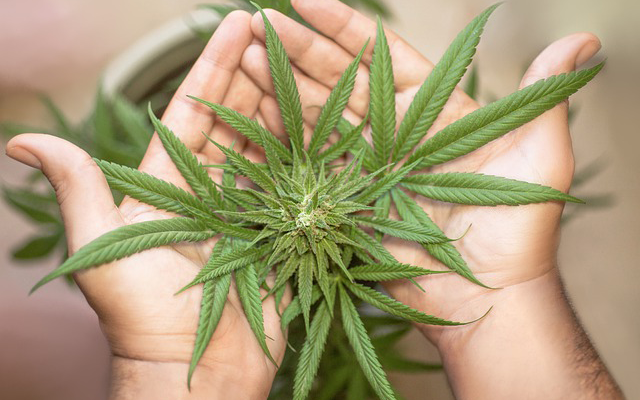Whether it’s cocktails, candies, clothing, or capsules, CBD is in everything and everywhere you can possibly imagine. And now, the intriguing ingredient has officially transitioned from being a wellness supplement to taking over the world of beauty and skincare. From sunscreen and serums to chapsticks, cleansers, and creams, there is an assortment of CBD-infused products turning up in beauty supply stores everywhere.
However, it is not as easy as checking for “CBD” on your ingredients’ label and calling it a day. There’s a slew of shady marketing out there and more than a couple of false claims. Therefore, with the introduction of CBD cosmetics into the beauty and skincare bazaar, we want to ensure the products are not only effective but also safe and non-toxic. With all that said, we’ve put together reams of studies from articles and experts straight to industry insiders, to get a primer on all things CBD skincare before adding them to your beauty routine.
First of All, What is CBD?
Cannabidiol (or CBD, for short), is one of the naturally occurring chemical compounds found in over a hundred composites of cannabis plants. Marijuana and hemp both belong to the same plant family, and while they have their differences, CBD can stem from either. THC or tetrahydrocannabinol is another compound found in cannabis plants that are active psychotropic. But unlike THC, CBD doesn’t get you ‘high’–not even close.
Although more research needs to be conducted on the ability of CBD to manage specific issues like insomnia and anxiety, and how CBD works, there are some key bases many industry specialists seem to agree on. According to Cindy Capobianco, as cited by TZR, CBD acts as an anti-inflammatory and analgesic. It has been used for centuries to successfully reduce pain and treat skin conditions such as psoriasis, eczema, and rosacea–even bug bites and sunburn–when used topically. When ingested, studies recommend that those similar properties can have a slightly different effect. It has the additional benefits of relief from anxiety, mood stabilization, and promoting a calm sense of well-being.
But, how does CBD work? As explained in the article published by Byrdie, CBD has thought to interact with an individual’s cannabinoid receptors. These receptors are found in every layer of the skin which trigger the body when there is an itch or pain. Topical CBD is designed to help those with painful conditions like post-herpetic neuralgia or those with pruritic skin conditions like eczema when the signals of the body are going ballistic. As illustrated in the same article, CBD is not necessarily focusing on eczema, but the hormones that are causing eczema to burn.
For a long time, hemp seed oil has been a common ingredient in skincare. However, experts claim that it’s not actually an active ingredient nor it has any specifically notable anti-inflammatory. That’s why CBD oil has been typically used in skincare products–with CBD creams, serums, masks, and face and body oils crossing over the beauty market.
Is CBD Suitable For You?
In the interview held by Forbes with Pekar, an NYC-based aesthetician, she stated some beneficial factors of using CBD oil like its healing properties. CBD offers some serious anti-inflammatory and antioxidant benefits which can be helpful in treating skin concerns like dryness, inflammation, and free radical damage. Moreover, as it helps decrease the production of sebum in the skin, CBD might also be effective in fighting acne. In addition, research indicates that CBD may be effective in treating psoriasis and eczema as well.
While studies on the benefits of CBD are relatively limited, it is substantially considered safe to use topically. Experts claim that there is no possible harm in the continuous use of a CBD-infused product on the skin. If a person happens to have a reaction from a CBD topical product, however, skincare specialists added that it is likely not from cannabidiol itself, but some other component of the product like a botanical.
With this in mind, they recommend choosing a high-quality CBD product that will not lead to poor results. Natural Health Mag CBD oils offer stronger and more effective CBD oil products that help the user gain the potential benefits he or she deserves from the plant. Let’s talk more about this below.
How to Choose the Right CBD Skin Care Product?
All CBD-infused products are formulated using broad-spectrum CBD oil, full-spectrum CBD oil, or Cannabidiol isolate.
As indicated in the article published by Forbes, a broad-spectrum CBD oil contains a mixture of cannabinoids, flavonoids, and terpenes derived from hemp, but no THC. Full-spectrum CBD oil, on the contrary, contains all the compounds found in hemp but with trace quantities of THC. Meanwhile, Cannabidiol isolate is considered the purest form of the product. It doesn’t include any other substances that are found in a hemp plant. This version of CBD oil is best for facial skin as it is pure, filled with skin-rejuvenating antioxidants, and doesn’t clog the pores.
Experts recommend looking for products that mention the keywords, “hemp extract,” “cannabidiol,” “full-spectrum CBD,” “broad-spectrum CBD,” or “hemp CBD” on the label. Also, keep in mind that cannabis Sativa seed oil or hemp seed oil isn’t the same thing as CBD oil. As specialists added in the article, CBD oil is extracted from the flowers and leaves of the hemp plant. It’s a lighter and finer oil as compared to hemp seed oil that is a bit greasier.
Another significant measure is to determine the quantity of CBD in a product. For example, if you are in search of oils and lotions for anxiety or pain relief, the CBD percentage must be higher to be effective. The most essential factor to consider, though, is the quality of the brand you’re buying. In a 2017 study published in the Journal of the American Medical Association, over 60% of online Cannabidiol products are mislabeled. That’s why experts advised that you must make sure that you have the confidence that the product is safe, you trust the brand, and that it contains precisely what the label claims it contains. It’s always best to choose products that have been tested in a third-party laboratory. Be sure to keep these things in mind when purchasing a CBD product.
How to Use It?
As discussed in Medical News Today, with any Cannabidiol product, it’s vital to follow the instructions on the packaging and label to determine how much to use, how often to use the product, and how to apply it.
For skin application, an individual can apply the oil or any CBD-based beauty and skincare products directly to the skin. To use it orally, the user can put a few drops of CBD oil under the tongue, where he or she can hold the oil for up to 1 minute before swallowing. The dosage will vary depending on the potency of the CBD oil and on a person’s body weight. Those who are new to CBD should start with the lowest possible dose. Once these people figured out how their body responds to CBD, they can gradually increase the dose to 2-5 mg.
So, what’s Next?
Clearly, CBD continues to be a fascination in the wellness space and the world of beauty and skincare. Although there is still a lot to learn about the Cannabidiol compound and research has just scratched the surface of its strength, the CBD industry is evolving every day and more experts are motivated to explore more.
Bear in mind, the potency and strength of CBD in beauty products may vary, which can impact its potential effectiveness. Thus, a person looking to use CBD skincare products should also think about the other ingredients within the product to help identify whether these may help address any cosmetic problems. For more inquiries and concerns, it’s always best to speak to an expert or a doctor if products with CBD contents are right for you.
Disclaimer: This article is intended for information and entertainment purposes only and is not intended to reflect the specific views of the publication.






